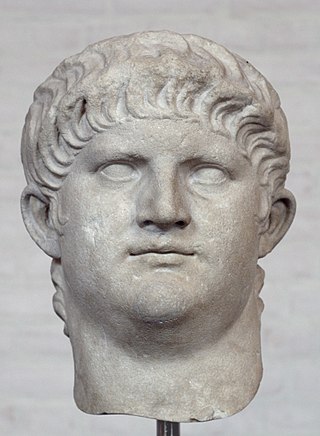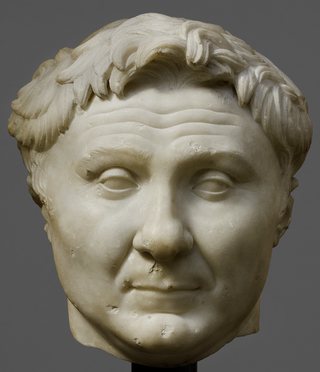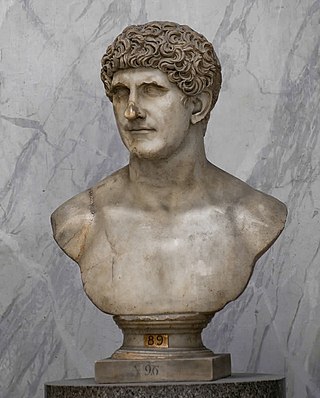
Nero Claudius Caesar Augustus Germanicus was Roman emperor and the final emperor of the Julio-Claudian dynasty, reigning from AD 54 until his death in AD 68.

Lucius Annaeus Seneca the Younger, usually known mononymously as Seneca, was a Stoic philosopher of Ancient Rome, a statesman, dramatist, and in one work, satirist, from the post-Augustan age of Latin literature.

Lucius Aelius Sejanus, commonly known as Sejanus, was a Roman soldier, friend, and confidant of the Roman Emperor Tiberius. Of the Equites class by birth, Sejanus rose to power as prefect of the Praetorian Guard, of which he was commander from AD 14 until his execution for treason in AD 31.

The gens Julia was one of the most prominent patrician families in ancient Rome. Members of the gens attained the highest dignities of the state in the earliest times of the Republic. The first of the family to obtain the consulship was Gaius Julius Iulus in 489 BC. The gens is perhaps best known, however, for Gaius Julius Caesar, the dictator and grand uncle of the emperor Augustus, through whom the name was passed to the so-called Julio-Claudian dynasty of the first century AD. The nomen Julius became very common in imperial times, as the descendants of persons enrolled as citizens under the early emperors began to make their mark in history.

Lucius Calpurnius Piso Caesoninus was a prominent Roman senator of the early Empire. His tenure as pontifex led him sometimes to be called Lucius Calpurnius Piso Pontifex, to differentiate him from his contemporary, Lucius Calpurnius Piso the Augur, consul in 1 BC. He was a confidant of the emperors Augustus and Tiberius.

The gens Pompeia was a plebeian family at ancient Rome, first appearing in history during the second century BC, and frequently occupying the highest offices of the Roman state from then until imperial times. The first of the Pompeii to obtain the consulship was Quintus Pompeius in 141 BC, but by far the most illustrious of the gens was Gnaeus Pompeius, surnamed Magnus, a distinguished general under the dictator Sulla, who became a member of the First Triumvirate, together with Caesar and Crassus. After the death of Crassus, the rivalry between Caesar and Pompeius led to the Civil War, one of the defining events of the final years of the Roman Republic.
Decimus Valerius Asiaticus was a prominent Roman Senator of provincial origin. Asiaticus was twice consul: first in 35 as suffect consul with Aulus Gabinius Secundus as his colleague; second in 46 as ordinary consul with Marcus Junius Silanus as his colleague. He was the first man from Gaul to be admitted into the Roman Senate, as well as the first man from Gaul to attain the consulship.

Pompeia Paulina was the wife of the statesman, philosopher, and orator Lucius Annaeus Seneca, and she was part of a circle of educated Romans who sought to lead a principled life under the emperor Nero. She was likely the daughter of Pompeius Paulinus, an eques from Arelate in Gaul. Seneca was the emperor's tutor and later became his political adviser and minister. In 65 AD Nero demanded that Seneca commit suicide, having accused Seneca of taking part in the Pisonian conspiracy against him. Paulina attempted to die with her husband, but survived the suicide attempt.
The gens Terentia was a plebeian family at ancient Rome. Dionysius mentions a Gaius Terentius Arsa, tribune of the plebs in 462 BC, but Livy calls him Terentilius, and from inscriptions this would seem to be a separate gens. No other Terentii appear in history until the time of the Second Punic War. Gaius Terentius Varro, one of the Roman commanders at the Battle of Cannae in 216 BC, was the first to hold the consulship. Members of this family are found as late as the third century AD.

Galeria Fundana was a Roman empress, the second wife of Roman emperor Vitellius.
The gens Vitellia was a family of ancient Rome, which rose from obscurity in imperial times, and briefly held the Empire itself in AD 69. The first of this gens to obtain the consulship was Aulus Vitellius, uncle of the emperor Vitellius, in AD 32.

The gens Antonia was a Roman family of great antiquity, with both patrician and plebeian branches. The first of the gens to achieve prominence was Titus Antonius Merenda, one of the second group of Decemviri called, in 450 BC, to help draft what became the Law of the Twelve Tables. The most prominent member of the gens was Marcus Antonius.
The gens Arruntia was a plebeian family at ancient Rome. Members of this gens first came to prominence during the final years of the Republic.
The gens Cuspia was a plebeian family of equestrian rank at ancient Rome. Few of its members obtained any of the higher offices of the Roman state, although Lucius Cuspius Camerinus attained the consulship in the time of Hadrian.
Publius Galerius Trachalus was a Roman senator, who was active during the middle of the first century AD. He was consul for the year 68 as the colleague of Silius Italicus and a noted Roman orator praised by Quintilian.
The gens Galeria was a Roman family of Imperial times. The family first rose to prominence under the Julio-Claudian dynasty, but the most illustrious person of the name was the emperor Galerius, one of the heirs of Diocletian, who reigned from AD 305 to 311, although he cannot have been a direct descendant of the earlier family.
The gens Hateria, occasionally Ateria, was a plebeian family at ancient Rome, known from the last century of the Republic and under the early Empire. The most distinguished of the Haterii was Quintus Haterius, a senator and rhetorician in the time of Augustus and Tiberius. He was consul suffectus in 5 BC.
Marcus Porcius Cato was a Roman senator active during the Principate. He was suffect consul in the latter half of AD 36 as the colleague of Gaius Vettius Rufus. Although he shares the identical name of several members of the Republican Porcii, Ronald Syme expressed reservations that he is related to that famed family. Stephen Dyson has cataloged 56 people living in the provinces of Roman Spain who took on the gentilicium "Porcius", who were either clientes or descendants of clientes of Cato the Elder while he was proconsul of Spain, which makes Syme's suspicions plausible.
The gens Silia was a plebeian family at ancient Rome. Members of this gens are mentioned as early as the fifth century BC, but first to hold the consulship was Publius Silius Nerva, in the time of Augustus. The Silii remained prominent until the time of the Severan dynasty, in the early third century.
Gaius Turranius was a Roman eques who flourished during the reign of the emperors Augustus, and Tiberius. He was appointed to a series of imperial offices, most notably praefectus or governor of Roman Egypt and later praefectus annonae.